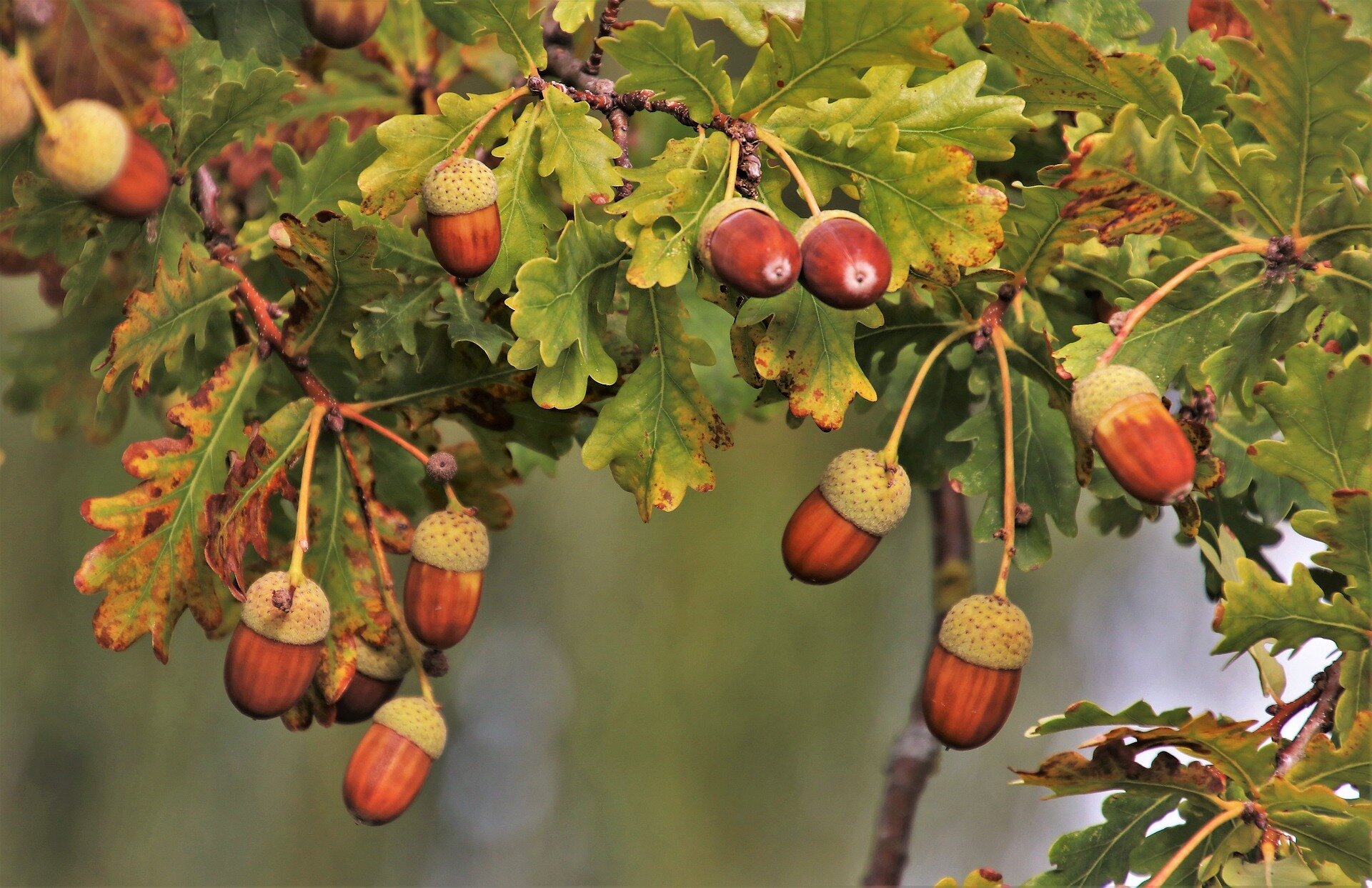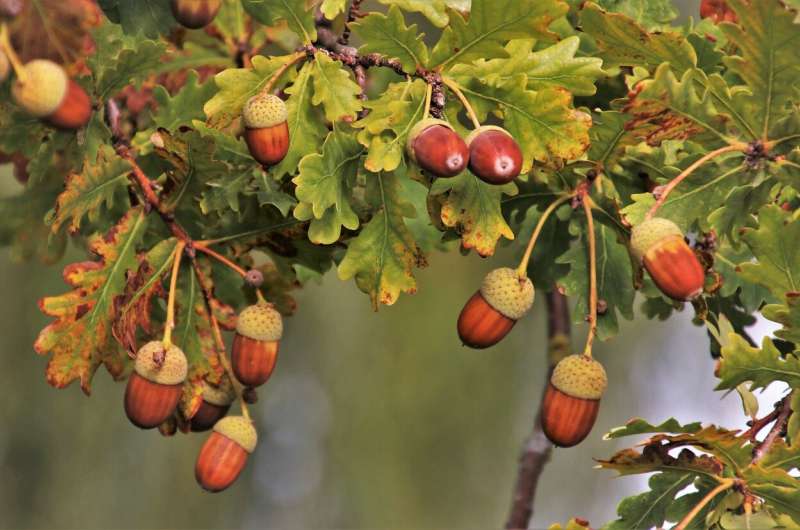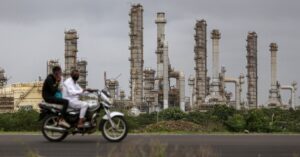

Around the globe, forests are facing unprecedented challenges. They’re grappling with wildfires, diseases, droughts and deforestation. The survival of these great forests hinges on their ability to regrow—and for many trees, a process called “masting” is key to this regeneration.
Masting—the unpredictable boom-and-bust cycle of seed production—can have profound consequences for plant populations and the food webs that are built on their seeds. But the complex relationship between seed-production cycles and seed consumers and dispersers has been poorly understood.
A new study by an international team of scientists that included millions of tree-year observations worldwide, published in Nature Plants, for the first time documents and analyzes the intricate balance between seed defense and dispersal by forest trees at a global scale. Researchers from 70 institutions contributed to the paper.
Seeds, fruits and nuts—high in carbohydrate, fat and protein content—are among the highest quality plant foods in nature, noted the study’s lead author Tong Qiu, assistant professor in Penn State’s College of Agricultural Sciences. When there are a lot of seeds, seed consumers such as birds, squirrels and insects have a feast. Their populations grow because there is plenty of food for them to eat and feed their offspring. But in the years following a mast, when seed production is low, these animals might struggle to find enough food, and this could lead to a drop in their populations.
“At the same time, some seeds that aren’t eaten during the mast year might germinate and grow into new trees, and this can lead to an increase in tree numbers, affecting the forest’s overall growth and the habitat for other creatures,” Qiu said. “Understanding masting patterns can guide forest managers in their conservation efforts. During lean years of seed production, conservationists may choose to plant seeds manually or implement measures to protect struggling animal populations.”
Erratic seed crops may help trees confound their seed predators, but Qiu and colleagues wondered what they do to the seed dispersers the trees may need to insure successful germination? If unreliable seed production that thwarts a tree’s “enemies” has the same negative impacts on their disperser friends, they hypothesized, then perhaps the tree species that rely most heavily on animal disperser species must forego this defensive option.
“When trees have big swings in seed production, take a long time between high seed years and all produce lots of seeds at the same time, predators can be overwhelmed,” Qiu said. “This seed-production strategy potentially hampers the ability of seed consumers to mitigate the effects of inter-annual fluctuations by foraging among various host trees. Our research revealed that masting relies on three critical aspects that affect both trees’ friends and foes, seed dispersers and seed predators.”
In the paper, the researchers introduce three elements of masting based on 12 million tree-year observations worldwide. The first is volatility, which reflects the amount seeds fluctuate year to year. The second is periodicity, which refers to the time interval between the years of high seed production. Third is synchronicity, representing a common trend where many trees bear large seed crops in the same years.
But there is a problem with this explanation for masting, pointed out the study’s senior author James Clark, Nicholas Distinguished Professor of Environmental Science at Duke University, who has built the Mast Inference and Forecasting network, better known as MASTIF.
The same tree species that attract seed predators may also depend on mammals and birds to disperse their seeds, he suggested. These friends are so valuable that many tree species pack their fruits and nuts with extra resources and advertise them with colorful displays, all to attract their important mutualist dispersers.
In the paper, the researchers evaluated whether the unreliable seed production that thwarts a tree’s enemies had the same negative impacts on their disperser friends. If masting effectively guards against enemies—and it does, they confirmed—then perhaps the tree species that rely most heavily on animal disperser species must forego this defensive option.
“An analysis of seed production in hundreds of tree species across five continents shows this mixed benefit of masting—the tree species that depend most on animal dispersers are the ones that avoid masting,” Clark said. “In the temperate forests of North America and Eurasia, oaks and firs are prolific mast species. Pines and spruces also mast, but to a lesser degree. Hickories and walnuts still less. Chestnut and the fleshy fruits of black gum, holly, hack- and sugarberry, persimmon, juniper, yew and pawpaw, hardly at all—they are reliable resources.”
The masting firs, pines and spruce fall prey to birds and many rodents in the canopy and also when they reach the forest floor, Clark added. In the tree, conifers can defend their seeds in woody, resin coated cones, many of which are armed with spines. Once on the forest floor, the exposed seeds are rapidly depleted by rodents. With few mutualist dispersers, they are prime candidates for masting.
Nutrient and climate gradient also play a role in masting, the researchers reported. Species that require a lot of nutrients tend to have low year-to-year changes in seed production, while those often found in nutrient-rich, warm and wet areas show shorter time intervals between high-seed- production years. Meanwhile, masting is more common in cold and dry places.
“Interestingly, this happens in areas where weather conditions mean there is less need for animals to spread seeds, unlike in the wet and warm tropics where such help from animals is more common,” Qiu said. “This fascinating interplay reminds us that our diverse forests are a result of countless factors working together in harmony, adapting to their unique circumstances to thrive.”
At the opposite extreme, rich, colorful fruits avoid wild fluctuations—the trees that produce them depend on their animal dispersers, Clark said. Although there is still plenty of year-to-year variation, because a large, expensive fruit is sensitive to moisture stress.
“A good two-week drought in mid-summer will see many trees abandoning much of their fruit crop—early abortion,” he said. “This includes not only fleshy fruits like persimmon, hackberry (including nettle tree in Europe), and black gum. Acorns and hickory nuts also have high moisture content; they too will abort many partially developed seeds to trim the resource demand. Still, a string of years with suitable climate conditions can see reliable crops in many of these species, one after another.”
More information:
Masting is uncommon in trees that depend on mutualist dispersers in the context of global climate and fertility gradients, Nature Plants (2023). DOI: 10.1038/s41477-023-01446-5
Provided by
Pennsylvania State University
Citation:
A seed survival story: How trees keep ‘friends’ close and ‘enemies’ guessing (2023, June 29)
retrieved 29 June 2023
from https://phys.org/news/2023-06-seed-survival-story-trees-friends.html
This document is subject to copyright. Apart from any fair dealing for the purpose of private study or research, no
part may be reproduced without the written permission. The content is provided for information purposes only.

